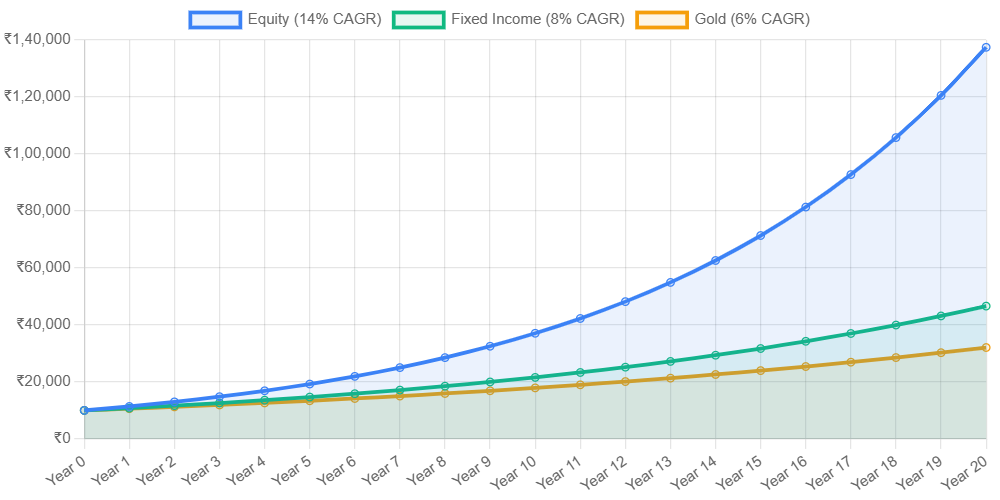Start Your Investment Journey
Transform your financial future. This guide turns complex stock market concepts into simple, interactive lessons. Scroll down to begin.
Why Invest? The Power of Growth
Saving money is good, but investing makes your money work for you, helping it grow faster than inflation. This section demonstrates the powerful difference between simply saving and actively investing your money over time. Use the interactive calculator to see your own potential.
The Market: What and Who
The stock market is a platform where you can buy ownership stakes (shares) in companies. This section introduces the core components of the market: the different places to invest your money (asset classes), the key players involved, and the regulator who ensures fair play for everyone.
Comparing Asset Classes
Different types of investments, or "asset classes," offer different levels of risk and potential return. The chart below shows the hypothetical growth of ₹10,000 over 20 years in various asset classes, based on historical average returns. Notice how equities have historically provided higher growth over the long term.

The Exchanges
The market's foundation. In India, the two main stock exchanges are the BSE (Bombay Stock Exchange) and NSE (National Stock Exchange), where all buying and selling happens electronically.
The Regulator
To ensure a fair and transparent market, the Securities and Exchange Board of India (SEBI) acts as the watchdog. It protects investors, prevents fraud, and sets the rules for all market participants.
Market Participants
Includes individuals like you (Retail), large Indian institutions like LIC (DIIs), Mutual Funds (AMCs), and major global investment funds (FPIs/FIIs).
Financial Intermediaries
These entities make the market work: Stock Brokers (your gateway to the market), Depositories (who hold your shares electronically), and Banks (for fund transfers).
The IPO Journey: From Idea to Public Company
Ever wonder how a company gets listed on the stock market? It's a journey that starts with an idea and involves several stages of funding before the company "goes public" through an Initial Public Offering (IPO). This section visualizes that journey.
Idea & Seed Fund
An entrepreneur has an idea. The first money comes from self, family, or Angel Investors.
Venture Capital
As the business grows, it attracts professional investors called Venture Capitalists (VCs) for expansion.
Private Equity
A mature, profitable company may get large investments from Private Equity (PE) firms to scale up globally.
Initial Public Offering (IPO)
The company sells its shares to the general public for the first time, getting listed on the stock exchange.
Recent Indian IPOs (2024-2025)
Company Name
Listing Period
Listing Day Gain/Loss
Ola Electric
Dec 2024
6.2%
Swiggy
Jan 2025
15.1%
PayU
Feb 2025
-2.5%
FirstCry
Mar 2025
22.0%
Aakash Education
Apr 2025
8.7%
Hexaware Technologies
Jan 2025
11.3%
IPO performance data is for illustrative purposes. Past performance is not indicative of future results.
Your Turn: Get Started with Trading
Ready to make a move? This section covers the practical steps. First, understand the key accounts you'll need. Then, define your style: are you a short-term trader or a long-term investor? Finally, try our interactive simulator to understand how different order types work.
1. Trading Account
Opened with a stock broker (e.g., Zerodha, Groww). This is where you place your buy and sell orders.
2. DEMAT Account
Linked to your trading account. It holds your shares electronically, like a bank account for stocks.
3. Bank Account
Your regular savings or current account, linked to your trading account for transferring funds in and out.
Contact Us for Any Queries
Address
Door No.10, Site No.5, RMR Fairlands, 4th Floor, Park Road, Fairlands, Salem 636016 Tamil Nadu India GSTIN 33AAGCH4131E1Z4
HQ: HST Investments Pvt Ltd, level 9, Olympia Teknos, Sidco inds Estate, Gunidy, Chennai 600032.
Contact@hstradeschool.com
hstradeschool@gmail.com
Phone
+918870694567
The IPO Journey: From Idea to Public Company
Ever wonder how a company gets listed on the stock market? It's a journey that starts with an idea and involves several stages of funding before the company "goes public" through an Initial Public Offering (IPO). This section visualizes that journey.
RBI Repo Rate
6.50%
As of Jun 2025
The rate at which RBI lends to banks. Stable rate suggests a watch-and-wait approach on inflation.
CPI Inflation (YoY)
4.83%
As of Apr 2025
Consumer price inflation. A downward trend is positive as it eases pressure on the RBI to raise rates.
IIP Growth (YoY)
5.0%
As of Mar 2025
Index of Industrial Production. Growth indicates a healthy industrial sector.
GDP Growth (YoY)
7.8%
As of Q4 FY24
Gross Domestic Product growth. A key measure of the economy's health.
Common Corporate Actions
Dividends
Company shares profits with its shareholders. A sign of financial health. (e.g., TCS, Reliance often declare dividends).
Bonus Issue
Company gives free extra shares to existing shareholders. This increases the number of shares and reduces the price per share.
Stock Split
Company divides existing shares into multiple shares to make them more affordable and increase liquidity.
Share Buyback
Company buys back its own shares from the market, reducing the number of outstanding shares, which can boost the share price.
Your Journey Continues
You've completed the first step! The world of finance is vast. Continue learning about Fundamental Analysis, Technical Analysis, and Risk Management to become a more informed investor.
This page is for educational purposes only and is not financial advice. All data is illustrative.
